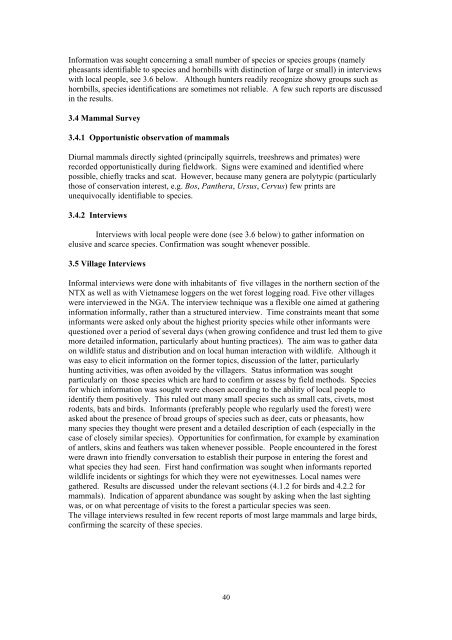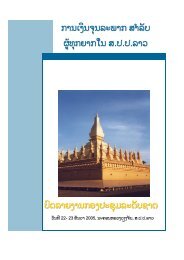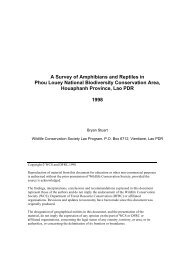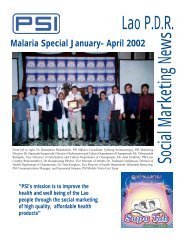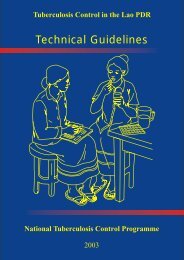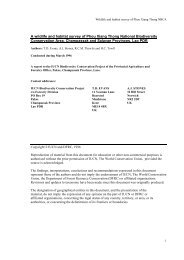A Preliminary Wildlife and Habitat Survey of the Proposed Northern ...
A Preliminary Wildlife and Habitat Survey of the Proposed Northern ...
A Preliminary Wildlife and Habitat Survey of the Proposed Northern ...
Create successful ePaper yourself
Turn your PDF publications into a flip-book with our unique Google optimized e-Paper software.
Information was sought concerning a small number <strong>of</strong> species or species groups (namelypheasants identifiable to species <strong>and</strong> hornbills with distinction <strong>of</strong> large or small) in interviewswith local people, see 3.6 below. Although hunters readily recognize showy groups such ashornbills, species identifications are sometimes not reliable. A few such reports are discussedin <strong>the</strong> results.3.4 Mammal <strong>Survey</strong>3.4.1 Opportunistic observation <strong>of</strong> mammalsDiurnal mammals directly sighted (principally squirrels, treeshrews <strong>and</strong> primates) wererecorded opportunistically during fieldwork. Signs were examined <strong>and</strong> identified wherepossible, chiefly tracks <strong>and</strong> scat. However, because many genera are polytypic (particularlythose <strong>of</strong> conservation interest, e.g. Bos, Pan<strong>the</strong>ra, Ursus, Cervus) few prints areunequivocally identifiable to species.3.4.2 InterviewsInterviews with local people were done (see 3.6 below) to ga<strong>the</strong>r information onelusive <strong>and</strong> scarce species. Confirmation was sought whenever possible.3.5 Village InterviewsInformal interviews were done with inhabitants <strong>of</strong> five villages in <strong>the</strong> nor<strong>the</strong>rn section <strong>of</strong> <strong>the</strong>NTX as well as with Vietnamese loggers on <strong>the</strong> wet forest logging road. Five o<strong>the</strong>r villageswere interviewed in <strong>the</strong> NGA. The interview technique was a flexible one aimed at ga<strong>the</strong>ringinformation informally, ra<strong>the</strong>r than a structured interview. Time constraints meant that someinformants were asked only about <strong>the</strong> highest priority species while o<strong>the</strong>r informants werequestioned over a period <strong>of</strong> several days (when growing confidence <strong>and</strong> trust led <strong>the</strong>m to givemore detailed information, particularly about hunting practices). The aim was to ga<strong>the</strong>r dataon wildlife status <strong>and</strong> distribution <strong>and</strong> on local human interaction with wildlife. Although itwas easy to elicit information on <strong>the</strong> former topics, discussion <strong>of</strong> <strong>the</strong> latter, particularlyhunting activities, was <strong>of</strong>ten avoided by <strong>the</strong> villagers. Status information was soughtparticularly on those species which are hard to confirm or assess by field methods. Speciesfor which information was sought were chosen according to <strong>the</strong> ability <strong>of</strong> local people toidentify <strong>the</strong>m positively. This ruled out many small species such as small cats, civets, mostrodents, bats <strong>and</strong> birds. Informants (preferably people who regularly used <strong>the</strong> forest) wereasked about <strong>the</strong> presence <strong>of</strong> broad groups <strong>of</strong> species such as deer, cats or pheasants, howmany species <strong>the</strong>y thought were present <strong>and</strong> a detailed description <strong>of</strong> each (especially in <strong>the</strong>case <strong>of</strong> closely similar species). Opportunities for confirmation, for example by examination<strong>of</strong> antlers, skins <strong>and</strong> fea<strong>the</strong>rs was taken whenever possible. People encountered in <strong>the</strong> forestwere drawn into friendly conversation to establish <strong>the</strong>ir purpose in entering <strong>the</strong> forest <strong>and</strong>what species <strong>the</strong>y had seen. First h<strong>and</strong> confirmation was sought when informants reportedwildlife incidents or sightings for which <strong>the</strong>y were not eyewitnesses. Local names werega<strong>the</strong>red. Results are discussed under <strong>the</strong> relevant sections (4.1.2 for birds <strong>and</strong> 4.2.2 formammals). Indication <strong>of</strong> apparent abundance was sought by asking when <strong>the</strong> last sightingwas, or on what percentage <strong>of</strong> visits to <strong>the</strong> forest a particular species was seen.The village interviews resulted in few recent reports <strong>of</strong> most large mammals <strong>and</strong> large birds,confirming <strong>the</strong> scarcity <strong>of</strong> <strong>the</strong>se species.40


